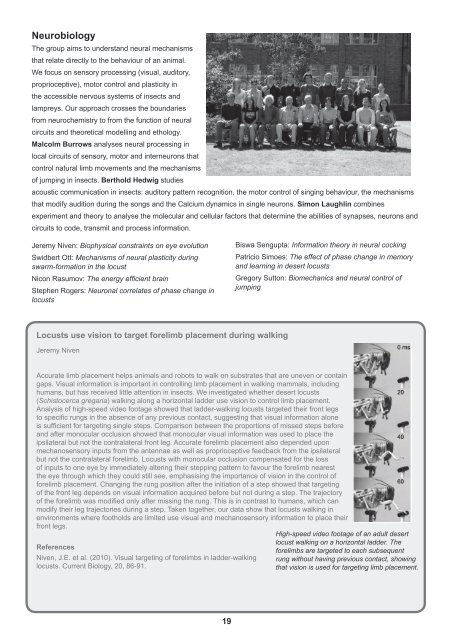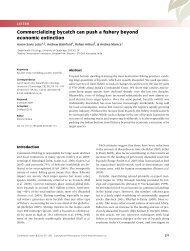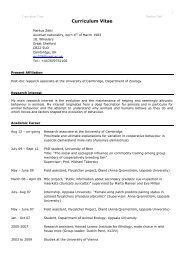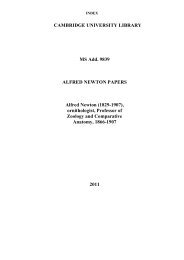Annual Report 2009 - Department of Zoology - University of ...
Annual Report 2009 - Department of Zoology - University of ...
Annual Report 2009 - Department of Zoology - University of ...
Create successful ePaper yourself
Turn your PDF publications into a flip-book with our unique Google optimized e-Paper software.
Neurobiology<br />
The group aims to understand neural mechanisms<br />
that relate directly to the behaviour <strong>of</strong> an animal.<br />
We focus on sensory processing (visual, auditory,<br />
proprioceptive), motor control and plasticity in<br />
the accessible nervous systems <strong>of</strong> insects and<br />
lampreys. Our approach crosses the boundaries<br />
from neurochemistry to from the function <strong>of</strong> neural<br />
circuits and theoretical modelling and ethology.<br />
Malcolm Burrows analyses neural processing in<br />
local circuits <strong>of</strong> sensory, motor and interneurons that<br />
control natural limb movements and the mechanisms<br />
<strong>of</strong> jumping in insects. Berthold Hedwig studies<br />
acoustic communication in insects: auditory pattern recognition, the motor control <strong>of</strong> singing behaviour, the mechanisms<br />
that modify audition during the songs and the Calcium dynamics in single neurons. Simon Laughlin combines<br />
experiment and theory to analyse the molecular and cellular factors that determine the abilities <strong>of</strong> synapses, neurons and<br />
circuits to code, transmit and process information.<br />
Jeremy Niven: Biophysical constraints on eye evolution<br />
Swidbert Ott: Mechanisms <strong>of</strong> neural plasticity during<br />
swarm-formation in the locust<br />
Nicon Rasumov: The energy efficient brain<br />
Stephen Rogers: Neuronal correlates <strong>of</strong> phase change in<br />
locusts<br />
Locusts use vision to target forelimb placement during walking<br />
Jeremy Niven<br />
19<br />
Biswa Sengupta: Information theory in neural cocking<br />
Patricio Simoes: The effect <strong>of</strong> phase change in memory<br />
and learning in desert locusts<br />
Gregory Sutton: Biomechanics and neural control <strong>of</strong><br />
jumping<br />
Accurate limb placement helps animals and robots to walk on substrates that are uneven or contain<br />
gaps. Visual information is important in controlling limb placement in walking mammals, including<br />
humans, but has received little attention in insects. We investigated whether desert locusts<br />
(Schistocerca gregaria) walking along a horizontal ladder use vision to control limb placement.<br />
Analysis <strong>of</strong> high-speed video footage showed that ladder-walking locusts targeted their front legs<br />
to specific rungs in the absence <strong>of</strong> any previous contact, suggesting that visual information alone<br />
is sufficient for targeting single steps. Comparison between the proportions <strong>of</strong> missed steps before<br />
and after monocular occlusion showed that monocular visual information was used to place the<br />
ipsilateral but not the contralateral front leg. Accurate forelimb placement also depended upon<br />
mechanosensory inputs from the antennae as well as proprioceptive feedback from the ipsilateral<br />
but not the contralateral forelimb. Locusts with monocular occlusion compensated for the loss<br />
<strong>of</strong> inputs to one eye by immediately altering their stepping pattern to favour the forelimb nearest<br />
the eye through which they could still see, emphasising the importance <strong>of</strong> vision in the control <strong>of</strong><br />
forelimb placement. Changing the rung position after the initiation <strong>of</strong> a step showed that targeting<br />
<strong>of</strong> the front leg depends on visual information acquired before but not during a step. The trajectory<br />
<strong>of</strong> the forelimb was modified only after missing the rung. This is in contrast to humans, which can<br />
modify their leg trajectories during a step. Taken together, our data show that locusts walking in<br />
environments where footholds are limited use visual and mechanosensory information to place their<br />
front legs.<br />
References<br />
Niven, J.E. et al. (2010). Visual targeting <strong>of</strong> forelimbs in ladder-walking<br />
locusts. Current Biology, 20, 86-91.<br />
High-speed video footage <strong>of</strong> an adult desert<br />
locust walking on a horizontal ladder. The<br />
forelimbs are targeted to each subsequent<br />
rung without having previous contact, showing<br />
that vision is used for targeting limb placement.





